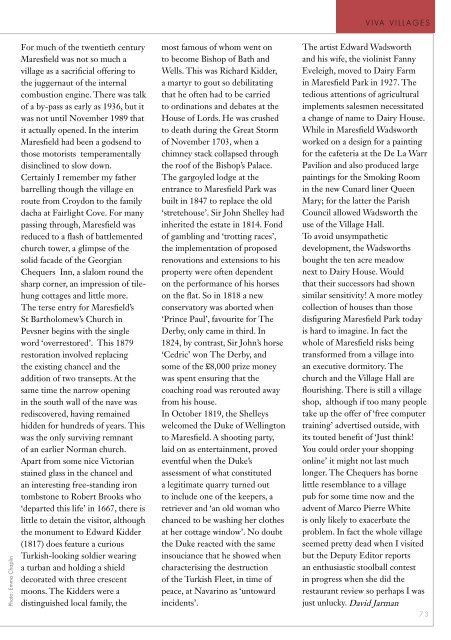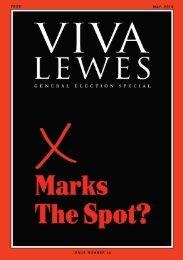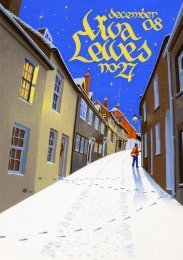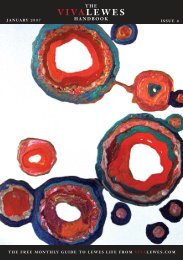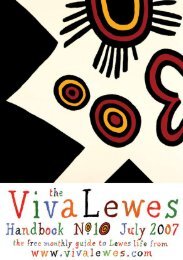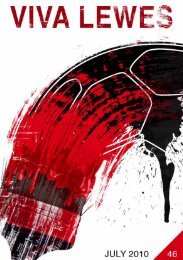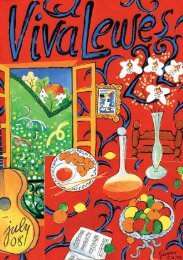Call us now on: 0800 731 5905 - Viva Lewes
Call us now on: 0800 731 5905 - Viva Lewes
Call us now on: 0800 731 5905 - Viva Lewes
Create successful ePaper yourself
Turn your PDF publications into a flip-book with our unique Google optimized e-Paper software.
photo: emma Chaplin<br />
For much of the twentieth century<br />
Maresfield was not so much a<br />
village as a sacrificial offering to<br />
the juggernaut of the internal<br />
comb<str<strong>on</strong>g>us</str<strong>on</strong>g>ti<strong>on</strong> engine. There was talk<br />
of a by-pass as early as 1936, but it<br />
was not until November 1989 that<br />
it actually opened. In the interim<br />
Maresfield had been a godsend to<br />
those motorists temperamentally<br />
disinclined to slow down.<br />
Certainly I remember my father<br />
barrelling though the village en<br />
route from Croyd<strong>on</strong> to the family<br />
dacha at Fairlight Cove. For many<br />
passing through, Maresfield was<br />
reduced to a flash of battlemented<br />
church tower, a glimpse of the<br />
solid facade of the Georgian<br />
Chequers Inn, a slalom round the<br />
sharp corner, an impressi<strong>on</strong> of tilehung<br />
cottages and little more.<br />
The terse entry for Maresfield’s<br />
St Bartholomew’s Church in<br />
Pevsner begins with the single<br />
word ‘overrestored’. This 1879<br />
restorati<strong>on</strong> involved replacing<br />
the existing chancel and the<br />
additi<strong>on</strong> of two transepts. At the<br />
same time the narrow opening<br />
in the south wall of the nave was<br />
rediscovered, having remained<br />
hidden for hundreds of years. This<br />
was the <strong>on</strong>ly surviving remnant<br />
of an earlier Norman church.<br />
Apart from some nice Victorian<br />
stained glass in the chancel and<br />
an interesting free-standing ir<strong>on</strong><br />
tombst<strong>on</strong>e to Robert Brooks who<br />
‘departed this life’ in 1667, there is<br />
little to detain the visitor, although<br />
the m<strong>on</strong>ument to Edward Kidder<br />
(1817) does feature a curio<str<strong>on</strong>g>us</str<strong>on</strong>g><br />
Turkish-looking soldier wearing<br />
a turban and holding a shield<br />
decorated with three crescent<br />
mo<strong>on</strong>s. The Kidders were a<br />
distinguished local family, the<br />
most famo<str<strong>on</strong>g>us</str<strong>on</strong>g> of whom went <strong>on</strong><br />
to become Bishop of Bath and<br />
Wells. This was Richard Kidder,<br />
a martyr to gout so debilitating<br />
that he often had to be carried<br />
to ordinati<strong>on</strong>s and debates at the<br />
Ho<str<strong>on</strong>g>us</str<strong>on</strong>g>e of Lords. He was cr<str<strong>on</strong>g>us</str<strong>on</strong>g>hed<br />
to death during the Great Storm<br />
of November 1703, when a<br />
chimney stack collapsed through<br />
the roof of the Bishop’s Palace.<br />
The gargoyled lodge at the<br />
entrance to Maresfield Park was<br />
built in 1847 to replace the old<br />
‘streteho<str<strong>on</strong>g>us</str<strong>on</strong>g>e’. Sir John Shelley had<br />
inherited the estate in 1814. F<strong>on</strong>d<br />
of gambling and ‘trotting races’,<br />
the implementati<strong>on</strong> of proposed<br />
renovati<strong>on</strong>s and extensi<strong>on</strong>s to his<br />
property were often dependent<br />
<strong>on</strong> the performance of his horses<br />
<strong>on</strong> the flat. So in 1818 a new<br />
c<strong>on</strong>servatory was aborted when<br />
‘Prince Paul’, favourite for The<br />
Derby, <strong>on</strong>ly came in third. In<br />
1824, by c<strong>on</strong>trast, Sir John’s horse<br />
‘Cedric’ w<strong>on</strong> The Derby, and<br />
some of the £8,000 prize m<strong>on</strong>ey<br />
was spent ensuring that the<br />
coaching road was rerouted away<br />
from his ho<str<strong>on</strong>g>us</str<strong>on</strong>g>e.<br />
In October 1819, the Shelleys<br />
welcomed the Duke of Wellingt<strong>on</strong><br />
to Maresfield. A shooting party,<br />
laid <strong>on</strong> as entertainment, proved<br />
eventful when the Duke’s<br />
assessment of what c<strong>on</strong>stituted<br />
a legitimate quarry turned out<br />
to include <strong>on</strong>e of the keepers, a<br />
retriever and ‘an old woman who<br />
chanced to be washing her clothes<br />
at her cottage window’. No doubt<br />
the Duke reacted with the same<br />
insouciance that he showed when<br />
characterising the destructi<strong>on</strong><br />
of the Turkish Fleet, in time of<br />
peace, at Navarino as ‘untoward<br />
incidents’.<br />
V I VA V I l l A G E s<br />
The artist Edward Wadsworth<br />
and his wife, the violinist Fanny<br />
Eveleigh, moved to Dairy Farm<br />
in Maresfield Park in 1927. The<br />
tedio<str<strong>on</strong>g>us</str<strong>on</strong>g> attenti<strong>on</strong>s of agricultural<br />
implements salesmen necessitated<br />
a change of name to Dairy Ho<str<strong>on</strong>g>us</str<strong>on</strong>g>e.<br />
While in Maresfield Wadsworth<br />
worked <strong>on</strong> a design for a painting<br />
for the cafeteria at the De La Warr<br />
Pavili<strong>on</strong> and also produced large<br />
paintings for the Smoking Room<br />
in the new Cunard liner Queen<br />
Mary; for the latter the Parish<br />
Council allowed Wadsworth the<br />
<str<strong>on</strong>g>us</str<strong>on</strong>g>e of the Village Hall.<br />
To avoid unsympathetic<br />
development, the Wadsworths<br />
bought the ten acre meadow<br />
next to Dairy Ho<str<strong>on</strong>g>us</str<strong>on</strong>g>e. Would<br />
that their successors had shown<br />
similar sensitivity! A more motley<br />
collecti<strong>on</strong> of ho<str<strong>on</strong>g>us</str<strong>on</strong>g>es than those<br />
disfiguring Maresfield Park today<br />
is hard to imagine. In fact the<br />
whole of Maresfield risks being<br />
transformed from a village into<br />
an executive dormitory. The<br />
church and the Village Hall are<br />
flourishing. There is still a village<br />
shop, although if too many people<br />
take up the offer of ‘free computer<br />
training’ advertised outside, with<br />
its touted benefit of ‘J<str<strong>on</strong>g>us</str<strong>on</strong>g>t think!<br />
You could order your shopping<br />
<strong>on</strong>line’ it might not last much<br />
l<strong>on</strong>ger. The Chequers has borne<br />
little resemblance to a village<br />
pub for some time <str<strong>on</strong>g>now</str<strong>on</strong>g> and the<br />
advent of Marco Pierre White<br />
is <strong>on</strong>ly likely to exacerbate the<br />
problem. In fact the whole village<br />
seemed pretty dead when I visited<br />
but the Deputy Editor reports<br />
an enth<str<strong>on</strong>g>us</str<strong>on</strong>g>iastic stoolball c<strong>on</strong>test<br />
in progress when she did the<br />
restaurant review so perhaps I was<br />
j<str<strong>on</strong>g>us</str<strong>on</strong>g>t unlucky. David Jarman<br />
7 3


